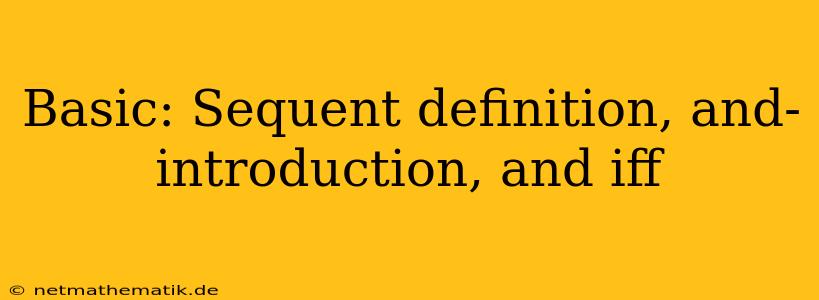In the realm of logic, understanding the fundamental concepts is paramount to unraveling complex arguments and constructing sound proofs. One such crucial concept is the sequent, a foundational element of sequent calculus. This article delves into the definition of a sequent, exploring its structure and purpose. We will also examine a specific rule of inference known as and-introduction and its application within sequent calculus. Furthermore, we will explore the connection between sequents and the logical connective iff, highlighting their crucial role in expressing logical equivalence. By gaining a comprehensive understanding of these concepts, we can navigate the complexities of formal logic with greater clarity and efficiency.
What is a Sequent?
A sequent is a fundamental construct in sequent calculus, representing a logical statement about the relationship between a set of assumptions (antecedent) and a set of conclusions (succedent). It is often written in the form:
Γ ⇒ Δ
where:
- Γ (Gamma) represents the antecedent, a set of formulas assumed to be true.
- ⇒ (turnstile) signifies logical implication, meaning that if all formulas in Γ are true, then at least one formula in Δ must be true.
- Δ (Delta) represents the succedent, a set of formulas that are claimed to be true given the assumptions in Γ.
For example, the sequent {p, q} ⇒ {p ∧ q} states that if both formulas p and q are true, then the conjunction p ∧ q must also be true.
The Role of And-Introduction
And-introduction is a rule of inference in sequent calculus that allows us to introduce a conjunction (∧) into the succedent of a sequent. It is represented by the following rule:
Γ ⇒ Δ, A Γ ⇒ Δ, B ---------------------- Γ ⇒ Δ, A ∧ B
This rule states that if we can derive both A and B from the assumptions in Γ, then we can conclude that A ∧ B is also derivable. In essence, and-introduction allows us to combine two separate conclusions into a single, more informative one.
Example of And-Introduction
Consider the following sequent:
{p, q} ⇒ {p, q ∧ r}
To apply and-introduction, we need to show that both p and q ∧ r are derivable from the assumptions p and q.
- p is already present in the succedent, so it is trivially derivable.
- We can derive q ∧ r by applying and-introduction again. We know q is derivable, and we can also derive r from the assumptions p and q using appropriate rules of inference. Therefore, we can conclude q ∧ r is derivable.
Since we have shown that both p and q ∧ r are derivable, we can apply and-introduction to derive the new sequent:
{p, q} ⇒ {p ∧ (q ∧ r)}
This demonstrates how and-introduction helps us to strengthen our conclusions by combining individual statements into conjunctions.
Sequent and IFF
The logical connective iff (if and only if) plays a crucial role in expressing logical equivalence. Two formulas A and B are logically equivalent if and only if they have the same truth value in all possible interpretations. This equivalence can be represented using the iff connective, written as A ≡ B.
In sequent calculus, iff can be expressed using two sequents:
- Γ ⇒ Δ, A ≡ B
- Γ ⇒ Δ, ¬(A ≡ B)
The first sequent states that given the assumptions in Γ, we can derive the equivalence of A and B. The second sequent states that we cannot derive the negation of the equivalence of A and B from the same assumptions.
This representation captures the essence of iff as a logical connective. To prove the equivalence of A and B, we must demonstrate that they have the same truth value in all possible interpretations. This is reflected in the two sequents above, where the first sequent confirms the equivalence, and the second rules out the possibility of their inequivalence.
Applications of Sequent Calculus
Sequent calculus is a powerful tool used extensively in various areas of logic and computer science:
- Automated Theorem Proving: Sequent calculus forms the basis for many automated theorem provers, which use logical rules to verify the validity of logical arguments.
- Logic Programming: Sequent calculus provides a framework for logic programming languages, where programs are expressed in terms of logical statements and rules.
- Formal Verification: Sequent calculus is used to formally verify the correctness of software and hardware systems by reasoning about their logical properties.
Conclusion
Understanding the sequent, and-introduction, and iff are essential for navigating the intricacies of formal logic. By mastering these concepts, we gain valuable tools for constructing sound arguments, proving logical statements, and effectively representing logical relationships. The use of sequent calculus provides a robust foundation for exploring the complexities of logic and its applications in various domains. The sequent remains a cornerstone of formal logic, serving as a versatile and expressive tool for representing and manipulating logical statements.
